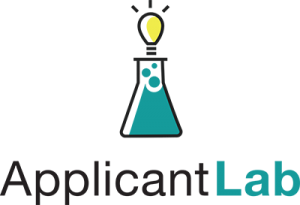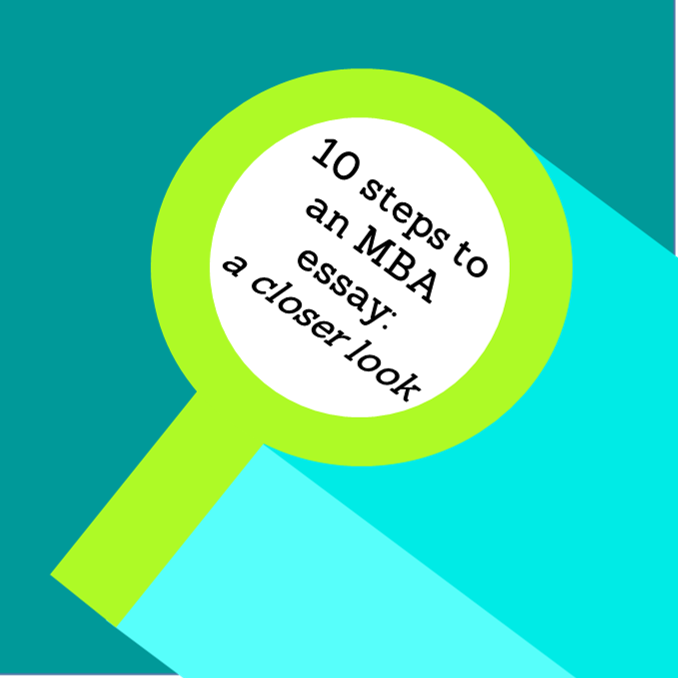I previously posted an infographic that quickly outlined the 10 steps you need to take to write a winning MBA admissions essay.
However, one of the limitations of infographics is that you can’t put a lot of explanation into them, since too much text defeats the purpose of an infographic!
So as a supplement to that post, I thought I’d create a more descriptive text version here:
The ten steps you need to write a strong MBA application esssay:
1) Identify your strengths and weaknesses:
You need to start with an honest sense of what the admisisons committee is going to think about you when they first read your application. What is their “gut feel” going to say?
Fair or not, you ARE going to be judged (at first!) with a quick read-through.
If you have any “red flags” or weaknesses in your profile (like a low GPA, limited international experience, attending a college that wasn’t “elite”, etc.), you need to create an action plan on day 1 on how to address those.
Sometimes you’ll address a weakness in a main essay, in the “optional essay”, in the letter of recommendation…sometimes you’ll take additional coursework or do additional activities in or out of work to make your porfile stronger. SOMETIMES, you won’t do anything at all, because those ridiculous “message board profile reviews” have psyched you out about a “weakness” that isn’t actually a big deal at all.
2) Determine what your “Career Vision” story is going to be:
Did you know that a “bad” Career Vision is [highlight color=”yellow”]#1 reason otherwise qualified applicants get rejected[/highlight]? You can have EVERYTHING going for you, but if you mess up the Career Vision, you’ll be in the rejection pile in no time. People new to the MBA admissions process often have no idea how important this is — they sometimes think that when a school asks about your career vision, it’s more of a casual, curious inquiry….as opposed to the fact that it can be the “make or break” issue (yes, this is an actual quote from an ISB admissions officer!)
3) Your “Why MBA? / Why our School?” argument should now flow naturally:
Once you’ve gotten a strong Career Vision in place, then coming up with an answer to “Why do you need an MBA?” becomes MUCH easier. If you try to figure out “Why MBA?” BEFORE your Career Vision, you will go in circles and waste a lot of time.
And then you will show your draft essay to an admissions consultant like me, and I will rightfully rip that essay into teeny, tiny pieces. GET CAREER VISION RIGHT *FIRST*, AND MAKE SURE IT’S A GOOD ONE, BEFORE YOU DO ANYTHING OTHER WRITING!
4) Move on to brainstorming your strongest leadership stories:
“Show, don’t tell” — it’s an common expression, and hey! It applies to MBA applications too. I can’t tell you how many essay drafts I’ve read where the applicant says something like, “I am a strong leader and a great team-player”. Uh. Ok. And we should believe you because…..WHY?
Sentences of the “I am wonderful at _____” variety are a WASTE OF SPACE. Prove to us that you have this awesome personal trait, by TELLING US A STORY ABOUT IT.
At the early steps in the admissions process, you will brainstorm any and every example you can think of. Don’t censor or edit yourself at this step. Ideally, take a few days and think of any possible example, from any facet of your life.
5) Now, take a step back to figure out which stories are the best (and create your “application brand” in the process):
Ok, now that you’ve got your list of any possible story you might use in your application, you now need to go through and assess each story’s strength. Which ones truly are the most promising? Which ones will show the sorts of things AdComs actually want to see?
(Hint: the “accomplishements” from work that you are proudest of MIGHT NOT BE the best ones to use for your MBA application! ApplicantLab guides you through what this means, in detail.)
6) ALLOCATE your top stories across each school’s essay questions…
Look at each school’s essay question(s), including the questions they have inside of the application form itself — in the obsession over essays, people often don’t realize that the admissions forms themselves have SEVERAL short-answer questions, and sometimes you’ll need “mini-essays” for those as well.
Look at each esssay question (and read ApplicantLab’s detailed guidance on how to tackle each one), and then start to allocate your top stories to each: e.g., “Ok, so the Widget Project story is going to go in MIT question #2, but I’ll mention it in passing in Haas’ question #1…”
7) …keeping your recommendations in mind at the same time!
Just like a great meal can be complemented by a great wine, your recommendations need to complement your essays (while giving you lots of compliments at the same time!). Story allocation is iterative: if your recommender only says the same stuff about you that you’re saying about yourself in the essays, then that’s a wasted opportunity. Your competitors are managing their recommenders’ messages carefully, and you should be too. Not only does ApplicantLab guide you through exactly what to ask your recommenders to say about you, it even gives you a document template that you’re going to give them to make sure their letter actually helps (not hurts!) you.
8) “Pre-writing” – jot notes on how you will answer every piece of the essay question
After my first year or two of admissions consulting, I realized that a step BETWEEN the outline and the rough draft was hugely beneficial. I call this step “pre-writing”, and it’s where we make sure that NOTHING falls through the cracks. In the ApplicantLab, I break out EVERY essay question into “mini-questions” — which, by the way, I’ve also heard from users that this has been a huge help in combatting writers’ block!
9) Rough Drafts (and I really mean “rough”)
I think everyone has their own idea of how to best create your first “rough draft” of the essay. I do things in a slightly weird way — I actually get people to complete their rough drafts SUPER quickly. Frankly, you might spend less time on the rough draft with me vs. what you spent on pre-writing. This is because I think that when people over-think their earliest draft, there is often a risk of ROBOT-BUSINESS-SPEAK coming in (“I maximized the ROI by leveraging global cross-functional synergies”)….a result of the combination of “self-consciousness” and “well, I guess they want to hear me use these big business words” (WRONG).
Rough drafts written that way are painful to read. PAINFUL. Trust me.
10) Final Drafts: polish for content, tone, brevity, and grammar
So, you’ve got your rough draft written — now it is time to CUT and SLASH and SCULPT it into something submission-worthy. Obviously, I go into tons of detail in the ApplicantLab, but the overall steps we take are to polish for content (is the important stuff in there? is there unimportant stuff that can be cut?). Then we check for tone — are you portraying yourself as capable yet likeable? These first two steps are the “Machete steps” — because we are CHOPPING things out — entire sentences, paragraphs at a time. Then we get increasingly precise — moving from the “machete” to the “scalpel” — by going through and cutting things down for brevity. Finally, once we think it’s shaping up — we go through and make sure the grammar’s ok (e.g., no “their / there / they’re” mistakes).
Try to take a day or two “off” between final draft revisions: the distance / “fresh eyes” will do you good!
Get someone (but not too many people!) to read your final drafts too. If you use ApplicantLab to get this far, you can hire an admissions consultant on an hourly basis (avg. cost, $270/hr), or you can hire ApplicantLab to do it for much less ($50) — because, to be blunt, if you’ve followed the ApplicantLab steps, editing your essay won’t be as time-consuming / painful, so it can done for much less money.
So, how much time does it take to write MBA essays, anyway?
Depending upon how many days you’ve got before the deadine, you can compress / expand the steps above as needed. For example, if you’ve got a few months before the deadline, you can spend a week or two on steps 1 – 3.
Deadline looming? You can write your MBA application essays in only a couple of weeks (one week, if you can truly focus for several days) if you go through ApplicantLab steps 1 – 5 in a day, spend a few hours on essay / recommendation allocation, then start on your final draft immediately after the rough draft. It won’t be easy, but it can be done — I had someone apply to three schools in one week last year! I don’t recommend this, because it was super-stressful, but it CAN be done!
What do you think? Did the steps above help clarify things? What questions do you still have?



